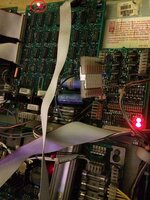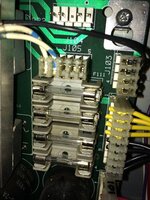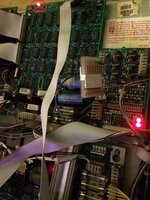W
Wizbiscuit
My STTNG has developed a rather odd fault...
When I turn it on about 75% of the time it does not work.
The led have have show on the picture is off (and another board to the left had side), so the power does not seem to be getting to the boards...

Now if I give it a nice push around this area...

The non-lit led pop on and the machine dances into life...
Now its a little hit-n-miss and often if I just push the connector at J105 it starts up, the odd thing though is I can actually disconnect J105 and the pin still runs, so it doesnt actually seem to be connected to J105... maybe the pressure is bending the board and fixing whatever connection is bad??? even when its working you hear that very slight sizzle sound that sounds like something being "just" connected...
The connectors just below this I can see are power, and I have re-crimped everything I can see, even put some new solder behind these connections to remove dry joints (though I am slighty guessing at this point)...
Before I continue on, any idea's what could be causing this??? oddly also is after the machines on, I can wiggle the cables and push connectors and it dont turn it off or reset it?? I would expect a loose connection would work both ways??
Got me flummoxed...
When I turn it on about 75% of the time it does not work.
The led have have show on the picture is off (and another board to the left had side), so the power does not seem to be getting to the boards...

Now if I give it a nice push around this area...

The non-lit led pop on and the machine dances into life...
Now its a little hit-n-miss and often if I just push the connector at J105 it starts up, the odd thing though is I can actually disconnect J105 and the pin still runs, so it doesnt actually seem to be connected to J105... maybe the pressure is bending the board and fixing whatever connection is bad??? even when its working you hear that very slight sizzle sound that sounds like something being "just" connected...
The connectors just below this I can see are power, and I have re-crimped everything I can see, even put some new solder behind these connections to remove dry joints (though I am slighty guessing at this point)...
Before I continue on, any idea's what could be causing this??? oddly also is after the machines on, I can wiggle the cables and push connectors and it dont turn it off or reset it?? I would expect a loose connection would work both ways??
Got me flummoxed...


